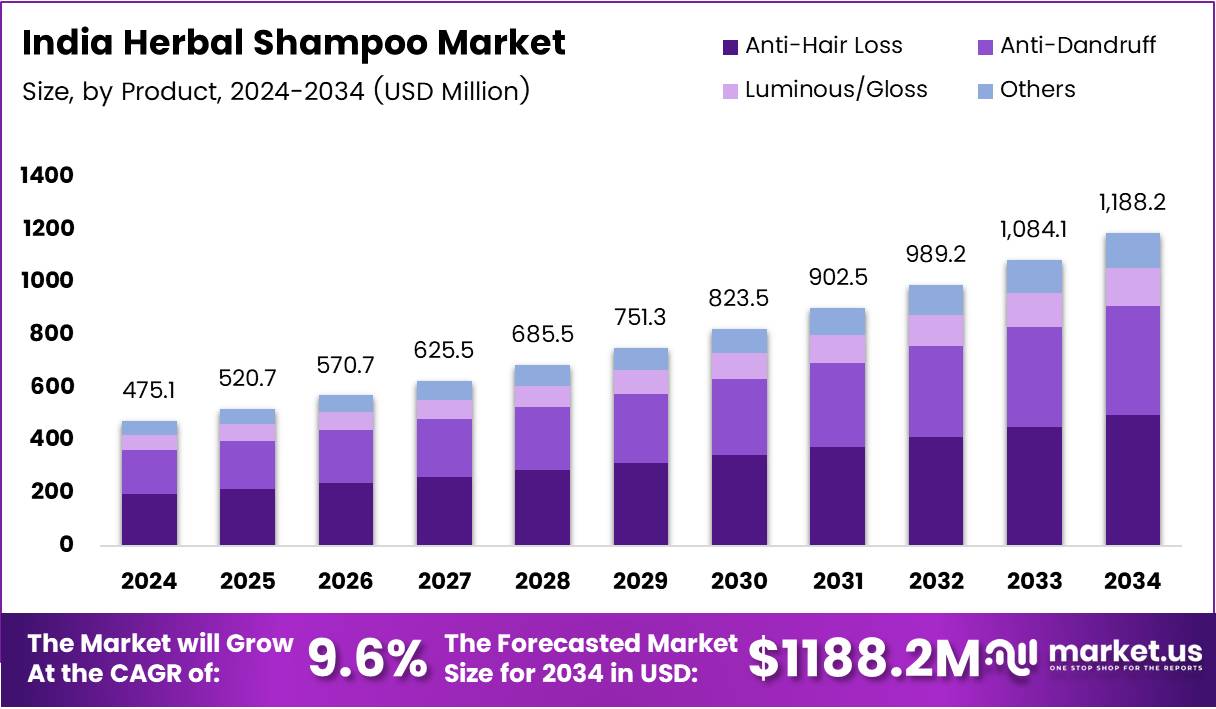Table of Contents
Introduction
The India Herbal Shampoo Market is witnessing significant growth, fueled by a rising preference for natural, chemical-free personal care products. As consumers become increasingly health-conscious, the demand for herbal shampoos formulated with natural ingredients continues to soar. With an expected market size of USD 1188.2 Million by 2034, up from USD 475.1 Million in 2024, the market is growing at a robust CAGR of 9.6% from 2025 to 2034. This growth is driven by shifts in consumer behavior, as they seek safer, eco-friendly alternatives to conventional synthetic shampoos.

Key Takeaways
- The India Herbal Shampoo Market is projected to reach USD 1188.2 Million by 2034, growing from USD 475.1 Million in 2024, at a CAGR of 9.6%.
- The Anti-Hair Loss segment leads the product category, driven by increased awareness of hair thinning and damage.
- Convenience Stores accounted for 56.2% of the market share in 2024, being the dominant distribution channel.
- Liquid formulations dominated the market with a 59.4% share in 2024 due to their versatility and ease of use.
- Women accounted for the largest share, representing 71.1% of the market in 2024, reflecting their higher spending power and awareness of hair care.
Key Market Segments
- By Product: The market is driven by Anti-Hair Loss shampoos, followed by Anti-Dandruff and Luminous/Gloss variants. The Anti-Hair Loss segment holds the largest share, driven by consumers seeking solutions for hair thinning and damage.
- By Distribution Channel: Convenience Stores lead the distribution channels, holding a 56.2% market share in 2024, followed by supermarkets, hypermarkets, and online stores.
- By Form: Liquid shampoos hold a dominant position, accounting for 59.4% of the market in 2024, while Bar shampoos and Powder shampoos also contribute to market diversification.
- By Gender: Women represent the largest consumer group, holding 71.1% of the market share in 2024, while Men are a growing segment due to increasing awareness of natural hair care.
Drivers
- Consumer Preference for Natural Products: The growing inclination towards chemical-free, natural products is the major driver for the herbal shampoo market. Consumers are becoming more aware of the potential harmful effects of synthetic chemicals, encouraging a shift to safer alternatives.
- Urbanization and Disposable Income: With rapid urbanization and rising disposable incomes, urban consumers are more inclined to invest in premium, natural hair care products.
- Rise of E-Commerce: The rapid growth of e-commerce platforms is expanding access to herbal shampoos, enabling consumers from tier 2 and tier 3 cities to explore a wide range of options.
- Government Support for Ayurvedic Products: The Indian government’s initiatives promoting traditional medicine and natural products play a crucial role in encouraging the production and use of herbal shampoos.
Use Cases
- Anti-Hair Loss Solutions: Consumers facing hair thinning or hair fall issues are increasingly turning to herbal shampoos containing natural ingredients like bhringraj and amla, known for their hair growth properties.
- Scalp Care: Herbal shampoos formulated with ingredients like neem, tulsi, and tea tree oil are popular for their anti-dandruff and soothing properties, catering to consumers looking to improve scalp health.
- Cosmetic Benefits: Shampoos designed to enhance hair shine, smoothness, and texture are also gaining popularity, especially among younger consumers who are more focused on hair aesthetics.
Major Challenges
- Higher Price Point: Herbal shampoos are typically more expensive than conventional shampoos, limiting their adoption among price-sensitive consumers, especially in rural areas.
- Quality Consistency: The availability of high-quality raw herbal ingredients can be inconsistent, which impacts the production volumes and consistency of the products.
- Lack of Standardized Certification: The absence of widely recognized quality certifications for herbal shampoos can create consumer skepticism and hinder market growth.
- Intense Competition from Synthetic Brands: Established synthetic shampoo brands, with their aggressive marketing strategies and strong brand loyalty, pose significant competition to herbal shampoo brands, making differentiation a challenge.
Business Opportunities
- Tier 2 and Tier 3 Cities: As disposable incomes rise in smaller cities, there is a significant opportunity to cater to consumers in these regions who are increasingly seeking quality personal care products.
- Customized and Targeted Products: Offering specialized shampoos for specific hair concerns such as dandruff, hair fall, and dry hair presents an opportunity for businesses to innovate and capture a larger market share.
- Global Expansion: With the growing global trend for natural personal care products, herbal shampoo brands in India have significant export potential. By tapping into international markets, Indian brands can expand their reach.
- Strategic Collaborations: Partnering with wellness influencers and leveraging digital marketing platforms offers an opportunity to enhance brand visibility and reach a wider audience.
Recent Developments
- Jan 2025: Havintha, an all-natural brand, appeared on Shark Tank India, pitching its business with a valuation of ₹25 crore, aiming to expand its market presence and attract investment.
- Feb 2024: Reliance Consumer acquired Velvette, a popular shampoo brand known for its sachet products, further solidifying its position in the affordable personal care market.
Conclusion
The India Herbal Shampoo Market is poised for significant growth, driven by rising consumer awareness of the benefits of natural, chemical-free hair care products. With the market projected to reach USD 1188.2 Million by 2034, brands have a unique opportunity to capitalize on the growing demand for herbal shampoos. Despite challenges like higher pricing and competition from established brands, the increasing preference for organic and Ayurvedic products, along with expanding access through online and retail channels, presents ample opportunities for innovation and growth.
Discuss your needs with our analyst
Please share your requirements with more details so our analyst can check if they can solve your problem(s)



